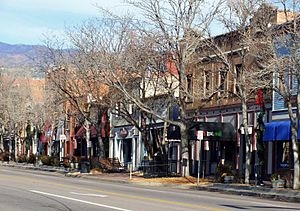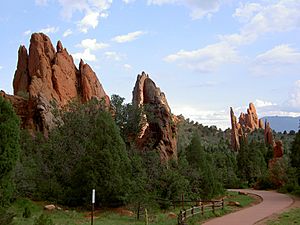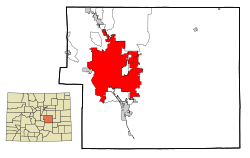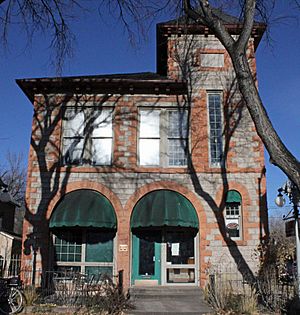Old Colorado City facts for kids
Quick facts for kids
Old Colorado City
|
|
|---|---|

Old Colorado City Business District
|
|
| Country | United States |
| State | Colorado |
| County | El Paso |
| City | Colorado Springs |
| Incorporated (town) | August 11, 1859 |
| Time zone | UTC-7 (MST) |
| • Summer (DST) | UTC-6 (MDT) |
|
Old Colorado City Historic Commercial District
|
|
| Lua error in Module:Location_map at line 420: attempt to index field 'wikibase' (a nil value). | |
| Location | N side of Colorado Ave. from 24th St., W to 2611 Colorado Ave., also includes 115 S. 26 St. and 2418 W. Pikes Peak Ave., Colorado Springs, Colorado |
| Area | 8 acres (3.2 ha) |
| Architect | Multiple |
| Architectural style | Western Victorian |
| NRHP reference No. | 82001018 |
| Added to NRHP | November 2, 1982 |
Old Colorado City, once known simply as Colorado City, is now a cool neighborhood in Colorado Springs, Colorado. Its main shopping area is so special that it was added to the National Register of Historic Places in 1982, meaning it's a historically important place. This area started way back in 1859 during the Pikes Peak Gold Rush, when people rushed to find gold. It became a busy spot for miners to get supplies and later, to process the gold they found. Many people living here also worked in the coal mines nearby. For a short time, it was even the capital city of the Colorado Territory! Today, Old Colorado City is a popular place for visitors, full of unique shops, art galleries, and yummy restaurants.
Contents
What's in a Name?

At first, this place was briefly called El Dorado. This name came from the gold mines found during the gold rush. The founders chose the name Colorado City because of the red sandstone rocks and red cliffs nearby. You can see these in places like the Rampart Range and Garden of the Gods. The word "Colorado" in Spanish means "blushing" or "red."
Where is Old Colorado City?
Old Colorado City is located in Colorado Springs, Colorado. Its general borders are U.S. Highway 24 to the south and 32nd Street to the west. To the east, it goes to 13th Street, and to the north, it reaches Uintah Street. The old town square is now a park called Bancroft Park.
A Look Back: History of Old Colorado City
How Old Colorado City Began
A group called the Colorado City Town Company claimed this land on May 22, 1859. The town was officially started on August 13, 1859. It was built where Fountain Creek and Camp Creek meet. This made it the very first settlement in the Pikes Peak area.
The founders, Melancthon Beach, Anthony Bott, George Bute, and Rufus Cable, had a big dream. They wanted Colorado City to be a main supply center for the new gold mines. These mines were in places like South Park and the Blue River. The town's spot was perfect because it was close to Ute Pass. This pass was the main route for miners heading west to the gold fields.
In 1859, Colorado City was part of the far western Kansas Territory. Later, on October 24, 1859, it became part of the Jefferson Territory. By 1861, over 300 cabins had been built. People living there included ranchers, farmers, and people who helped gold prospectors get supplies.
The Capital City and County Seat
The Colorado Territory was created on November 5, 1861. Colorado City was the capital of this new territory for a short time. This lasted until August 14, 1862, when the capital moved to Golden.
Even though it was the capital, Colorado City only really served as the capital for five days. When the territory's leaders met there on July 7, 1862, they found the meeting place too small. It was just a log cabin! So, they voted to leave on July 11 and meet in Denver instead.
El Paso County was also formed in 1861. Colorado City was the county seat, which means it was where the county government was located. This lasted until 1873, when the courthouse moved to Colorado Springs.
Coal Mining in the Area
People started mining coal in Colorado Springs as early as 1859. When the coal industry was at its busiest, there were about 50 coal mines. Most of these were in the Rockrimmon and Cragmor areas. Many mine workers lived on the west side of town, like in Old Colorado City. The people who invested in the mines often lived in fancier areas like the Old North End.
Getting Around: Transportation
Old Trails and Roads
There were several important roads leading into the area. One was a toll road that connected to the northeast with the "Despatch Express Route" from 1865. To the south, a stage road (now Old Stage Road) went through a canyon to Cripple Creek. Another road, the Ute Pass Wagon Road, went through North and South Cheyenne Canyons and then west.
Another important route was the north-south Cherokee Trail / Jimmy Camp Trail. This trail was part of the Trapper's Trail, which explorers and trappers used from the 1820s. The Trapper's Trail ran from Fort Laramie in the north to the El Pueblo trading post in what is now Pueblo County. From there, it branched off to other places like Bent's Old Fort.
Railroads Bring Growth
|
||||||||||||||||||||||||||||
In 1883, the Colorado Midland Railroad arrived in Colorado City. The railroad's main offices and operations were based in the town. This was a big deal!
Many businesses moved to the area to be close to the convenient train access. These businesses created thousands of jobs. They included ore processing mills, a paint factory, a glass works, and an iron works. Banks, restaurants, hotels, and other shops opened along Colorado Avenue. Many people in the town also worked for the railroad.
Gold Rush and Processing Mills
Major gold discoveries happened west of Colorado City during the Cripple Creek Gold Rush in the 1890s. The town grew quickly because gold ore was sent there to be processed. Also, gold prospectors came to buy supplies and find entertainment.
Gold processing mills were built in Colorado City in the 1890s. Soon, Colorado City was processing much of the gold ore from Cripple Creek. There were four processing companies in Colorado City before 1912. The Golden Cycle Mill had a better way to process the gold. By 1912, the other mills had closed down.
Colorado City was also the site of a big workers' strike in 1903. This strike spread to Cripple Creek and led to the Colorado Labor Wars. In the 1910s, the demand for railroads and ore processing mills went down. This caused the economy of Colorado City to slow down.
Becoming Part of Colorado Springs
Part of Old Colorado City was officially joined with Colorado Springs in 1898. The rest of it was fully added to Colorado Springs in 1917. It was then called West Colorado Springs, but most people just called it the West Side.
A Special Historic District
Since the mid-1970s, people have worked hard to bring Old Colorado City back to life. They wanted to show off its historical charm. This included making buildings look like they did a century ago. They also buried power lines and added nice landscaping.
Buildings were painted in colors popular around the early 1900s. Modern signs were removed or replaced. Old architectural details were uncovered and restored.
In 1982, the Old Colorado Historic Commercial District was added to the National Register of Historic Places. This means it's a very important historical area. It includes 27 properties, mostly along Colorado Avenue.
The earliest buildings were simple one-story structures made of wood and brick. Later, fancier two-story red brick buildings were built. These often had styles like Queen Anne, Romanesque Revival, and Italianate style architecture. Bancroft Park, with its bandshell and an old pioneer cabin, is also part of this historic area.
Old Colorado City Today
Today, Old Colorado City has a lively shopping district. You can find art galleries, unique boutiques, tasty restaurants, and fun tourist shops. Some special places to visit include Simpich Showcase and Magic Town at The Michael Garman Museum and Gallery.
Famous People From Old Colorado City
- Irving Howbert: One of the people who helped start Colorado Springs. He lived in Old Colorado City for a short time before 1864.
- Paulina Peavy: An American artist known for her paintings. She was also an inventor, designer, sculptor, poet, writer, and speaker. She was born in Old Colorado City on August 24, 1901.
Images for kids







